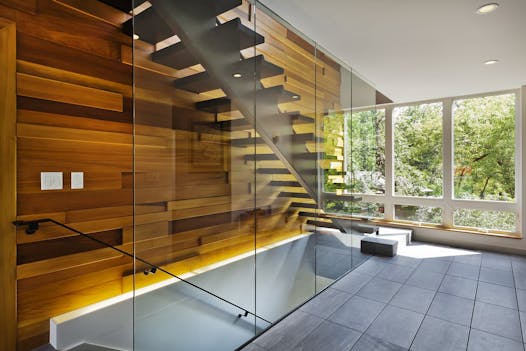Reinventing an older home or building a new one is a huge commitment — and expense. Where do you start?
Architects are pros at problem-solving — from maximizing natural light to devising floor plans that flow — and in the end, adding immeasurable value to your home, the biggest investment you'll make.
On April 19, a panel of architects will share smart remodeling and home design strategies at a residential architecture event, "The Value of Great Design," sponsored by AIA Minnesota and the Star Tribune.
Here, the architects joining the panel discussion — Michael Roehr, Bryan Anderson, Beth Reader and Gar Hargens — weigh in on how to stretch your renovation dollars, the influence of Houzz, mudroom "suites" and why we're living like "The Jetsons."
MICHAEL ROEHR
RoehrSchmitt Architecture • roehrschmitt.com
Hire an architect because ... A home designed for a client's specific needs has more character and soul than a tract house out of a plan book, resulting in a home that fits. "When working with an architect, you have to be ready for a bit of a journey. You spend more time exploring experiences and the kinds of places that make you feel good."
Smart design: When remodeling, you can transform a room by knocking down walls to open it up, and add windows and color in just the right spots. "We also look around a house and see lots of spaces not being utilized," he said. If you absolutely need to add on, it's more effective to reorganize the entire floor plan at the same time, he added. In older homes, "the bones are strong with good hardwood floors but for future energy savings, the systemic guts of the house — the appliances, heating and cooling — should be upgraded."
Bring the outdoors in: Simple solutions such as adding windows and French doors visually open a house to the outside, making it feel bigger. "You feel like you're occupying the entire site — instead of just inside a box," he said. Don't forget to create transitional zones, such as a front porch or patio, to greet and say goodbye to friends.
Must-have mudroom: "Instead of just a place for the boots, the mudroom has become the mud-suite," he said. Typical mudrooms encompass extensive storage cubbies and cabinets, charging stations, computer desks and sometimes even a bathroom with a shower. "You end up with a sizable area devoted to coming and going."
Biggest renovation challenge? In an older home, it's discovering what's behind the walls and allocating a big chunk of the budget on updating the old electrical and plumbing systems, he said. "People want to get to the fun stuff, but it has to be done to make the house viable for the long term."
Mod, mod world: Thanks to endless websites, HGTV and other media, more people are exposed to modern architecture and seeking "openness, clean lines and a style they can relate to better than a traditional bungalow." Owning a modernist house is no longer considered elite, he said. "We hear a lot of people lamenting that there aren't enough modern homes to choose from."
Smart control: Today's high-tech home automation systems can turn off the A/C, open shades, run appliances and monitor lights via smartphones and laptops."A few years ago, it was like 'The Jetsons,' but in the next decade, they will be standard in new houses," he said.
BETH READER
Reader & Swartz Architects, Winchester, Va. readerswartz.com
What an architect brings to the table: Architects explore every component, from the path of the sun on the site to how to optimize existing spaces, she said. "We can maximize the project in terms of aesthetics and function — and balance budget, time and quality for a good solution."
Blend old and new: A bump-out on an older house, a common renovation project, can be a tricky endeavor. That's because many clients want the new part to be light-filled and open, yet still respect the character and scale of the original home. Even though everyone always wants more space, "it's important to make sure the addition doesn't overwhelm an older house, which can be smaller in scale," she said.
If an addition isn't in the budget – or the best solution: Taking down walls and reconfiguring existing space can achieve better flow, aesthetics and a link to the outdoors."Houses tend to feel bigger when we use lots of windows to draw in daylight and spaces connect to the outside," she said. The kitchen is an essential piece to open up to the rest of the rooms. "We're doing larger kitchen islands to prepare meals and have a glass of wine. That room is more social than ever before."
Making a home livable for the long term: Many baby boomers are opting for main-floor master suites or a study that could be converted to a bedroom later. In renovations, Reader devises wider doorways and an inclined walkway to the front entry for the possibility of future limited mobility. "We've made stacked closets on two levels so it can eventually be used as an elevator."
Green-minded: More clients are inquiring about geothermal heating and cooling systems. "Fiber-cement siding is replacing traditional wood and stucco. It's low-maintenance and has lots of benefits," she said.
Biggest renovation challenge? "Budget. People always want to build more than they can spend," she said. One solution is to phase in projects later to make them more affordable. "And create flex spaces that offer multiple functions, to keep the square footage down."
GAR HARGENS
Close Associates • closearchitects.com
Why have an architect in your corner: Houzz.com, Dwell, HGTV and scores of other home-related websites, at best, give you some decor and design ideas, at worst, are excessive information overload, he said.
An architect will design a plan that's specifically tailored for you — not an adaptation of a Houzz image. "They'll write a program on exactly what you need — from the number of burners on the stove to the character and feeling you want to have in a space," he said. Architects also are experienced in working with cities and navigating the local regulations, he added.
Re-use instead of tearing down: Many people want to stay in their neighborhood, yet wish to update and upgrade their older homes. When doing a whole-house renovation, consider keeping the basement and first-floor structure, which can result in serious cost savings, said Hargens.
When rebuilding or adding on, respect the massing of surrounding homes and reflect the shapes of neighboring windows and doors. But you don't have to mimic the period of the house next door or your home's original architecture, which can be "a real budget killer."
"Build of your time," he said. "Create today's architectural history."
Big impact for a small cost: Replacing light fixtures and designing a strategic lighting scheme using LED bulbs will "enhance a space and set a mood," he said.
Less is more: Many of his designs for new contemporary residences are defined by less square footage, simple shapes, fewer but larger windows and less-expensive materials, such as corrugated metal siding. Lacewood and other affordable exotic woods are exposed on accent walls to warm up spaces.
Sustainability for the future: Many of Hargens' clients can't afford the upfront costs of geothermal systems or photovoltaic solar panels right away. So during construction, Hargens will design provisions for future energy-saving installations.
BRYAN ANDERSON
SALA Architects • salaarc.com
Why hire an architect? "We can see the bigger picture and potential," he said. "And we're trained to find the right balance with all the infinite possibilities."
The mission driving home renovations: Many owners want to emulate the 21st-century lifestyle and look showcased in endless glossy magazines and websites. But there's more to it than that, he said.
"They want to open up closed-off spaces, such as the kitchen, to encourage family togetherness time." He sees many kitchens expanding in size to include a comfortable lounging area. "The great room concept is still popular."
Smart improvements: New lighting and more glass can impact interior aesthetics. "Floating bars of light can bring a lot of 'wow' to a room and save energy," he said. Although it's not easy to make a Minneapolis foursquare all glass, if building new or adding on, "large fixed panes of glass can bring a lot of enjoyment to a space."
What's hot in the kitchen: Granite is no longer the go-to countertop. Quartz, recycled paper and even upper-end plastic laminates are more in demand, he said. "But if you want granite, a black countertop is a neutral backdrop and timeless." If the kitchen is integral to other living spaces, "we make the cabinets look like fine furniture."
Comfortably modern: In new construction and renovations, more clients are asking for industrial metal and iron accents, glass walls and stark gallery-white rooms. "But we need to balance these cool elements with warm, natural woods," he said. "It's a more European aesthetic of soft washed-out tones."
Lynn Underwood• 612-673-7619




